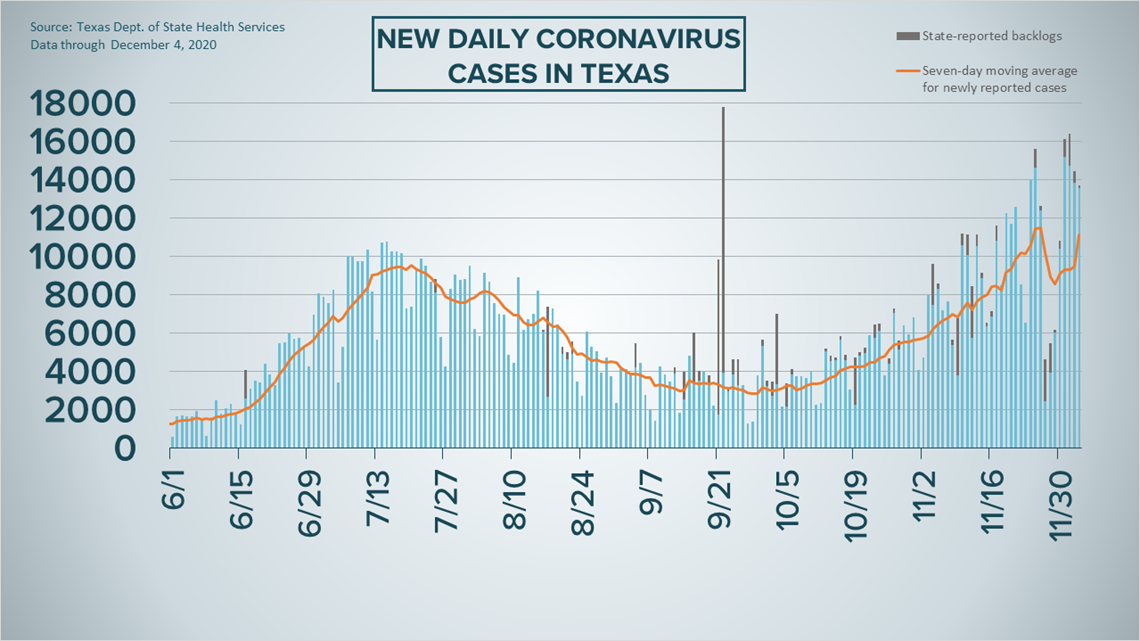SAN ANTONIO — We're tracking the latest numbers from the coronavirus pandemic in San Antonio and across Texas. Here are the latest numbers reported by Bexar and surrounding counties:
- Bexar County: 1,316 new cases were reported on Friday, bringing the total number of cases to 85,201. Four new deaths were also reported, raising the death toll to 1,376.
- Hays County: Officials in Hays County on Friday reported 82 new cases in the county and one additional COVID-related fatality. As of Friday, there are a total of 7,644 lab-confirmed local cases (785 of which are active), while the death toll rose to 106. 6,753 residents have recovered from the virus.
- Comal County: Comal County reported an additional 146 coronavirus cases – 112 are confirmed, and 34 are probable – on Friday, bringing its total to 4,932. No new death from COVID-19 complications was reported by local officials, so the local death toll remains at 131. The county estimates 568 active cases on Friday.
More county case information is available through the Texas Department of Health Services COVID-19 dashboard.
How Bexar County is trending
We've tracked how many coronavirus cases have been confirmed in Bexar County from the time officials began reporting cases in March 2020. The graphic below shows the number of cases since June and charts those daily case numbers along a 7-day moving average to provide a more accurate picture of the overall coronavirus case curve in our area and the direction we're trending amid the pandemic.
On Friday evening, San Antonio Mayor Ron Nirenberg reported an additional 1,316 novel coronavirus cases in Bexar County. The mayor also reported four more virus-related deaths. In all, 85,201 county residents have been diagnosed with COVID-19 and 1,376 have died from virus complications.
Nirenberg said the seven-day rolling average for daily cases, one of the strongest indicators of the virus's reach in the community, jumped to 952, up more than 200 cases per day since yesterday.


Hospitalizations dropped Friday, with six fewer patients receiving treatment for COVID-19 symptoms. A total of 587 are hospitalized at area facilities (including 48 from the El Paso region, down 22 in the last 24 hours). Of those, 126 patients are on ventilators and 207 are in ICU; Friday marked the first time since late-August with more than 200 COVID-19 patients in intensive care.


Coronavirus in Texas
The total number of novel coronavirus cases in the state since the pandemic began grew by 13,699 on Friday, according to the Texas Department of State Health Services.
That total includes 13,581 new confirmed cases and 118 cases attributed to backlogs not previously reported in the state's total (more details can be found at the top of this page).
As of Friday, more than 1.351 million Texans have been diagnosed with COVID-19. Of those, 1.228 million diagnoses are confirmed via molecular testing, while another 59,737 are positive antigen tests.


State health authorities also reported 255 additional virus-related deaths on Friday, which is the most in one day since July 30. At least 22,255 Texans have died from COVID-19 complications.
The number of COVID-19-related hospital patients, meanwhile, dropped for the first time in a week by 136 patients over the past 24 hours; the overall figure is now at 9,015 as hospital systems in the Lone Star State continue to contend with steadily increasing numbers of patients.
Meanwhile, the state estimates that 1,1012,700 Texans have recovered, while 197,126 Texans remain ill with COVID-19.
The latest update from the Texas Education Agency showed that there have been 65,552 cumulative cases among staff and students across the state through Nov. 29. That number comprises 40,985 positive student cases and 24,567 staff cases. More information can be found here.
The TEA releases new data on school cases every Thursday.


Latest Coronavirus Headlines
Coronavirus symptoms
The symptoms of coronavirus can be similar to the flu or a bad cold. Symptoms include fever or chills, cough, shortness of breath or difficulty breathing, fatigue, muscle or body aches, headache, new loss of taste or smell sore throat, congestion or runny nose, nausea or vomiting and diarrhea, according to the Centers for Disease Control.
Most healthy people will have mild symptoms. A study of more than 72,000 patients by the Centers for Disease Control in China showed 80 percent of the cases there were mild.
But infections can cause pneumonia, severe acute respiratory syndrome, kidney failure, and even death, according to the World Health Organization. Older people with underlying health conditions are most at risk.
But infections can cause pneumonia, severe acute respiratory syndrome, kidney failure, and even death, according to the World Health Organization. Older people with underlying health conditions are most at risk.
Experts determined there was consistent evidence these conditions increase a person's risk, regardless of age:
- Chronic kidney disease
- COPD (chronic obstructive pulmonary disease)
- Obesity (BMI of 30 or higher)
- Immunocompromised state (weakened immune system) from solid organ transplant
- Serious heart conditions, such as heart failure, coronary artery disease, or cardiomyopathies
- Sickle cell disease
- Type 2 diabetes
The CDC believes symptoms may appear anywhere from two to 14 days after being exposed.
Human coronaviruses are usually spread...
- Between people who are in close contact with one another (within about 6 feet).
- Through respiratory droplets produced when an infected person coughs, sneezes or talks. These droplets can land in the mouths or noses of people who are nearby or possibly be inhaled into the lungs.
- Some recent studies have suggested that COVID-19 may be spread by people who are not showing symptoms.
Help stop the spread of coronavirus
- Stay home when you are sick.
- Eat and sleep separately from your family members
- Use different utensils and dishes
- Cover your cough or sneeze with your arm, not your hand.
- If you use a tissue, throw it in the trash.

